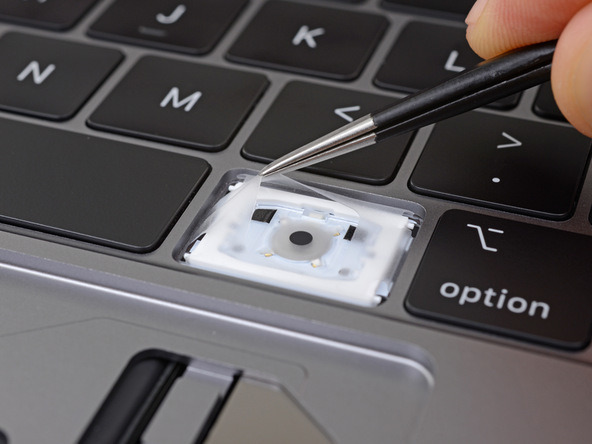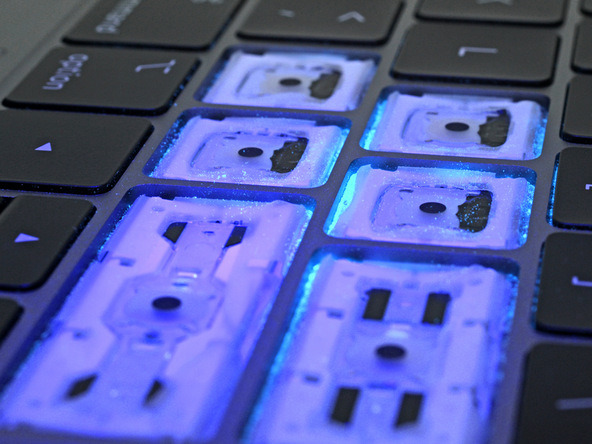The addition of the silicone membrane to the butterfly keyboard in the 2018 MacBook Pro may not be that effective in keeping the mechanism free from debris, after testing shows particles can still bypass the protection and cause issues with typing.
Part of an examination of the 2018 MacBook Pro, iFixit tested the theory that the membrane is meant to protect the key mechanism, by applying a variety of particulates to the keyboard and finding its breaking point.
The initial test using a fine-powdered paint additive found the membrane pushed the dust to the edges, keeping the mechanism clear. Adding more dust and typing aggressively does eventually allow dust to slip in between the membrane and the keycap covering the hole where the keycap clips pass through the silicone layer.
After finding the system isn't fully protective of the mechanism, the team moved on to using sand, eventually leading to the key failing to function.
On Wednesday, it was discovered some internal and service documentation for the 2018 MacBook Pro claimed the membrane was included to "prevent debris from entering the butterfly mechanism." Other documents for US personnel and service providers do not make the same claim, while marketing copy has simply mentioned the new keyboard is quieter, without stating anything about it improving reliability.
After removing enough hardware to gain access to the keyboard, the team had to remove all 64 keycaps in order to pull apart the main keyboard layer. The membrane itself turns out to be a "single die-cut and molded sheet" that is applied to the casing before the main section of the keyboard.
A related patent application submitted in March for the membrane is thought to explain how the membrane functions, such as the gaps in the membrane existing to allow both for keycap attachment and to allow key presses without interference from an air cushion. One described implementation sandwiches the membrane between the keyboard and the keycap without connecting it to either, similar to what was discovered in the teardown.
It was also discovered the keycaps used in the new keyboard have received a slight redesign compared to the version used in 2017, with the thickness reduced down from 1.5mm to 1.25mm. It is speculated this gives the keys more room to travel, as well as easier access to pry off individual keys, including the space bar.
The introduction of the membrane is likely to have been prompted by a number of cases where the mechanism failed in the 2016 and 2017 MacBook Pro, as well as the MacBook. The issues caused Apple to launch a keyboard service program that provided affected users with free servicing on their notebooks.
Apple has also become the subject of lawsuits over the matter, with two separate class action complaints against the company in May alone calling the butterfly mechanism prone to failure.
 Malcolm Owen
Malcolm Owen








-m.jpg)







 Charles Martin
Charles Martin



 William Gallagher
William Gallagher
 Christine McKee
Christine McKee
 Marko Zivkovic
Marko Zivkovic








58 Comments
Good job Apple.
"
You have got to be fking kidding me.
The issue is not keys "free from debris". (What keyboard does that??) The issue is
jesus cri!
AI’s numbers suggested (I believe) a max failure rate of the old design of 5%, so if this even halves that, the new rate will be 2.5%. I don’t know what the industry standard is but that actually sounds fairly reasonable to me. Ilwahar amazes me is all the pundits who said up until this issue to believe data over anecdotes. Now all the sudden the only data we have doesn’t matter, only the anecdotal experiences of said pundits.
Very much enjoyed reading the iFixit article. If Ive and Co. are not planning to once and for all make Mac notebook keyboards IP67-ready, they need to be. Tiny particles of dust or even sand should not bring down any Mac keyboards. Such hardware needs to be ready for the real world. Not to mention, it's bad PR the this is a possibility, IMO.
Loving my trusty MBA.